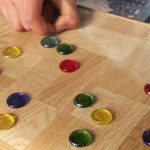

井伊直弼 II Naosuke
1815 – 1860
Know the Other Side of the “Cold-blooded Dictator”
Naosuke, a Late Bloomer
Naosuke was born in 1815 in Oumi (Shiga Prefecture) as the 14th son, to a father who was the Hikone Domain leader. When Naosuke was born, his father was already retired, and Naosuke’s brother was governing the Hikone Domain. Naosuke, who had many older brothers, had to have all 13 of his brothers dead or adopted to inherit his father’s status, which was almost impossible. Although Naosuke was born into a family that ruled one domain, he lived in a small house and lived a simple life, waiting for the day of inheritance. At the age of 20, Naosuke and his younger brother got offered to be adopted into a family in Edo, so they visited Edo together. However, only his brother ended up being adopted and got a better life, while Naosuke returned to Hikone alone. Naosuke likened himself to “a tree that never blooms” and called his small house “a house for a tree that never blooms.” When he was 35 years old, a turning point suddenly occurred in his life. Naosuke was appointed to be a Hikone domain leader because the previous leader (one of Naosuke’s brothers) died suddenly, and all brothers had been adopted by other Daimyo families at the time. So Naosuke, a late bloomer, became the leader of the Hikone Domain.
Hobbies in the Small House
Before Naosuke was appointed to become the Hikone domain leader, he lived in a small house without being able to get married, while having many hobbies, and actually lived a fulfilling life. He enthusiastically studied poems, Japanese hand drums, Zen (Japanese meditation), and martial arts. He especially liked to study the tea ceremony that he mastered to the point where he became a professional. He also studied Ancient Japanese Culture from Nagano, a scholar. Nagano later had a strong relationship with Naosuke and became a vassal.
Achievements as the Hikone Leader
Naosuke was a famous leader who set forth a lot of policies that helped the people of Hikone. He always cared so much for his people that he even wrote a poem about his worry over their poverty. Naosuke fired people who weren’t doing a good job, and instead of them, he promoted people based on their talent and potential. He hired people who he trusted the most, such as Nagano, a master of Ancient Japanese Culture, and his brothers-in-law. He also enriched his people’s lives by sharing his brother’s legacy, and by giving up all the luxury items he had as the leader. He visited his people many times, listening to their stories and looking around the town to understand their poor daily lives.
Promoted to a Chief Minister
Japan was in a state of confusion because they didn’t know what to do about the successor to the leader of the Shogunate and whether they would open the country when Naosuke got suddenly promoted to the highest position of Edo-Shogunate, a Chief Minister. He handled politics and diplomacy with his decisive leadership. On the other hand, busy Naosuke had no time and chance to return to Hikone anymore, which made him completely change from his caring and loving Hikone leader self. He became an autocratic politician who had many enemies around because of his dictatorship.
Naosuke’s Biggest Decision
In 1856, Harris Townsend came to Japan to urge the conclusion of the “Treaty of Amity and Commerce Between the US and the Empire of Japan” which was disadvantageous to Japan. The Japanese emperor was opposed to signing the unfair treaty but Naosuke signed the treaty at his discretion. Naosuke, of course, tried to get the emperor’s permission but he was threatened by the United States as he believed that they would not help Japan from the war that was about to occur in Japan if he didn’t sign.

Naosuke Oppressed More Than 100 Samurais
In 1853, there was a huge conflict between Naosuke’s group and Mito Domain’s group. What triggered it was because they wanted to nominate different leaders to be the next Shogun, the top leader of the country, as the successor for the previous one was sick. It is also because the group of people who didn’t want to open the country hated the way Naosuke signed the treaty with Americans without the Employer’s permission. Overall, some people felt as if Naosuke was a selfish dictator. Naosuke was cracking down on those who rebelled against him. He imprisoned and brutally executed more than 100 samurai including the talented human resources Japan would have needed. It can be considered that Naosuke tried to protect the weakened Shogunate’s authority, and the oppression was the only way to regain its power. Even then, this incident caused Naosuke to incur a lot of enemies.
Naosuke’s Final Day
On a cold snowy day in 1860, Naosuke got attacked when he was heading to Edo Castle from his house that was only 0.3 miles away. Since Naosuke’s 60 guards were in heavy clothes in preparation for the snow and could not counterattack quickly, it only took about 10 minutes for samurai from Mito Domain to kill Naosuke. After this incident, called “the Sakurada Gate Incident”, the Shogunate lost its authority. The day before he was assassinated, he wrote a poem that states, “My passion towards Japan will be understood by the world after I die”. Naosuke might have known that he would be resented and killed for what he had done, but he had done that just so he could protect Japan.
Wagyu, the Reason for Naosuke’s Death?
Behind the assassination, there was a Wagyu beef-related conflict that occurred between Naosuke and Nariaki Tokugawa (Mito Domain leader). Naosuke’s hometown, Hikone, was famous for the best quality wagyu beef, called Oumi-Beef. The beef was extremely delicious that the Shogunate and Daimyo leaders asked Hikone to send the miso-pickled beef as a remedy, due to eating meat being prohibited at the time. Nariaki was the one who was looking forward to tasting the Oumi-beef that he would get from Hikone every year. In 1850, Naosuke the devout Buddhist banned the killing of beef, so miso-pickled beef was no longer able to be delivered to anyone. Many Daimyo leaders were disappointed. Nariaki was also very disappointed, so he sent his messenger to Naosuke many times to beg for beef. But since Naosuke never responded to Nariaki’s request, Nariaki must have been mad at him, as a grudge over food can’t be forgiven easily. Nariaki must have known the plan to murder Naosuke at the Sakurada Gate Incident. If Naosuke had given Nariaki Oumi-beef, he probably would have tried to help Naosuke.
Naosuke’s Cushion
When Naosuke got attacked, he was sitting on a cushion in the palanquin. The cushion is kept safely at the temple in Shiga Prefecture, Naosuke’s hometown, to this day since Naosuke’s subordinates carried this bloody cushion all the way from Edo to Hikone to hide his death. The cushion is made from high-quality kimono cloth and tiger fur. The cushion sounds too expensive for Naosuke to have considering he was not the person who liked having luxury items during his time alive. It is said that Naosuke was heading to Edo Castle on that day for a traditional Japanese celebration, assuming that he was dressed very nicely.
.
.
.




